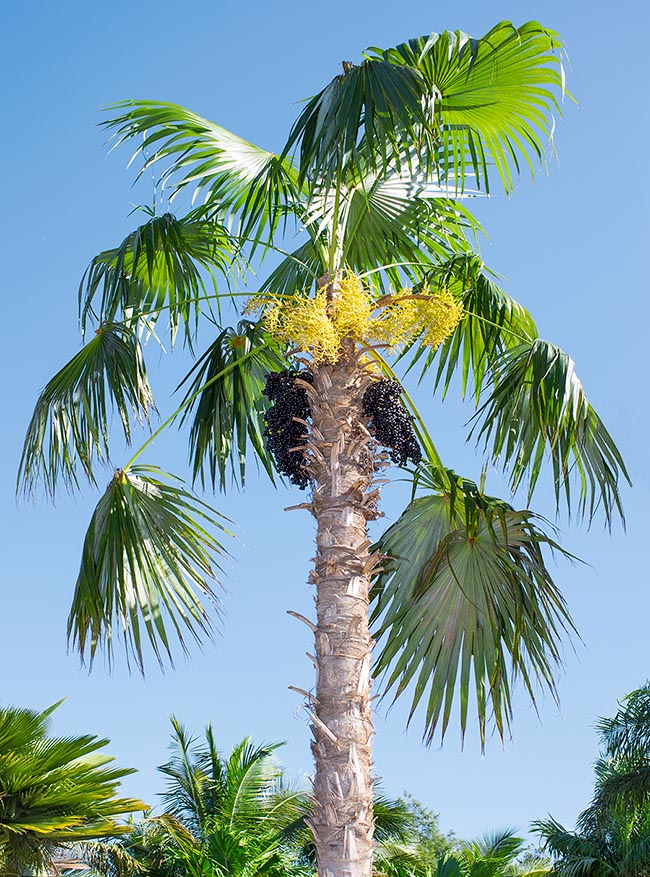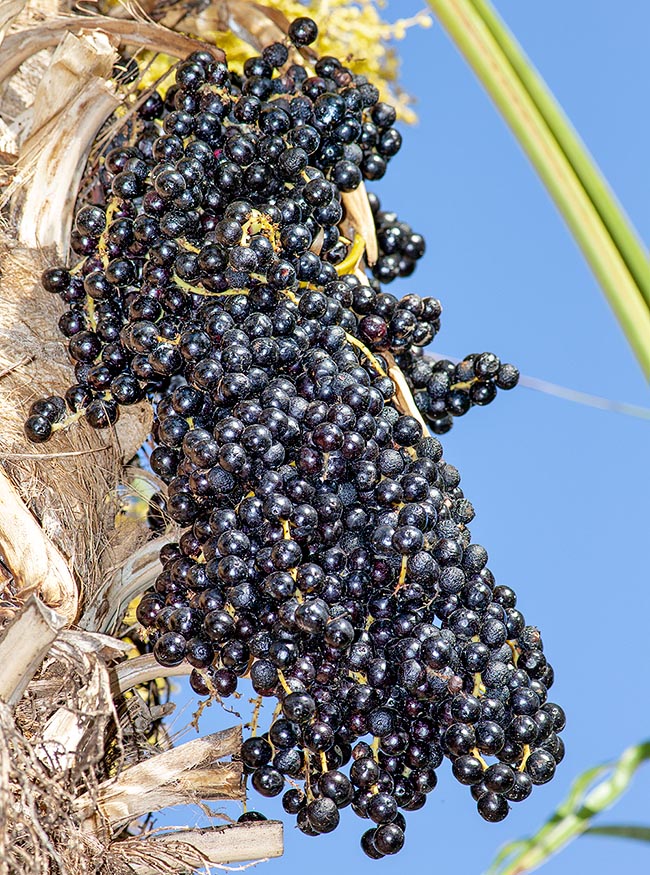Family : Arecaceae

Text © Pietro Puccio

English translation by Mario Beltramini

Native to Barbados and also the adjacent Caribbean islands, from Puerto Rico to north-eastern Venezuela, the Coccothrinax barbadensis can be 15 m tall with elegant palmate, orbicular, leaves © Giuseppe Mazza
The species is native to Antigua and Barbuda, Barbados, Dominica, Guadeloupe, Martinica, Puerto Rico, St. Lucia, Trinidad and Tobago, north-eastern Venezuela and Virgin Islands where it lives in the forests and coastal thickets on calcareous soils, from the sea level up to about 300 m of altitude.
The generic name comes from the combination of the Greek term “κόκκος” (coccos) = berry and of the name of the genus Thrinax to which these plants resemble; the specific latin name “barbadensis” = of Barbados refers to one of the places of origin.
Common names: Barbados silverpalm, broom palm, silver palm,silver thatch, thatch palm, tyre pal (English); latanier balai, palmier à balai (Guadeloupe); latanier balai, latanye bouril, latanier bourrique, latanye mawon, latanier savanne, palma kojo (Haiti); palma plateada (Puerto Rico); guano, palma de abanico, palma de guano (Dominican Republic); latanyé (St. Lucia); caraca, carana, coquito, mapire, palma de abanico, palma de escoba (Venezuela).
The Coccothrinax barbadensis (Lodd. ex Mart.) Becc. (1908) is an unarmed monoecious species with single stem, 8-15 m tall, and of 10-18 cm of diameter, of greyish colour in the oldest part, covered in the youngest one by the fibrous foliar bases arranged in two layers, with thin fibres thick less than 0,5 mm strictly intertwined.
The leaves, on an up to 1 m long petiole not fissured at the base, are palmate, orbicular, up to about 1,2 m long, of glossy intense green colour above, silver grey below.
The foliar lamina is incised in 35-67 linear-triangular segments with slightly drooping acuminate apex, bifid in the terminal part, 60-75 cm long at the centre and united at the base for little less than 1/3 of their length; the segments are run by numerous secondary veins connected by transversal veins.

The tiny 7-12 mm fruits, blackish purple when ripe, are an important source of food for the avifauna © G. Mazza
Inflorescences among the leaves (interfoliar) shorter than the petioles, curved, ramified, with 3-10 primary spaced ramifications and of length decreasing towards the apex. Hermaphrodite flowers, on a 1-2 mm long pedicel, of whitish colour, fragrant, with 9-12 stamens. Slightly depressed globose fruits, of 0,7-1,2 cm of diameter, of blackish purple colour when ripe, containing only one cerebriform seed of 0,5-0,8 cm of diameter. The fruits are an important source of food for the avifauna that contributes to the dispersion of the seeds.
It reproduces by seed, previously kept in water for three days, in sandy loam maintained humid at the temperature of 26-28 °C, with germination times starting from 2-3 months or more.
Among the most elegant of the genus, of great landscape effect solitary, in group or in rows on the sides of roads and boulevards, is cultivable in the tropical, subtropical regions and marginally in those with milder warm temperate climate, where temperatures around the 0 °C are short lasting exceptions. It requires full sun and adapts to various types of soil, even if poor, provided draining, but grows faster in those rich and regularly watered during the long warm and dry seasons, furthermore it resists the strong winds and the marine sprays. In the places of origin the leaves are utilized as material for covers and for fabricating brooms, this has led, due to the indiscriminate collection, to a remarkable reduction of its presence in some islands.
Synonyms: Thrinax parviflora Maycock (1830); Thrinax barbadensis Lodd. ex Mart. (1853); Copernicia barbadensis (Lodd. ex Mart.) Devansaye (1875); Thringis latifrons O.F.Cook (1901); Thringis laxa O.F.Cook (1901); Coccothrinax eggersiana Becc. (1908); Coccothrinax eggersiana var. sanctae-crucis Becc. (1908); Coccothrinax latifrons (O.F.Cook) Becc. (1908); Coccothrinax laxa (O.F.Cook) Becc. (1908); Coccothrinax martinicaensis Becc. (1908); Coccothrinax sanctae-thomae Becc. (1908); Coccothrinax australis L.H.Bailey (1947); Coccothrinax boxii L.H.Bailey (1949); Coccothrinax discreta L.H.Bailey (1949); Coccothrinax dussiana L.H.Bailey (1949); Coccothrinax sabana L.H.Bailey (1949).
